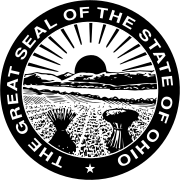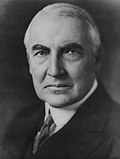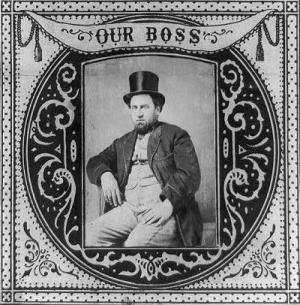
The United States presidential election of 1920 was the 34th quadrennial presidential election, held on Tuesday, November 2, 1920. In the first election held after the end of World War I and the ratification of the Nineteenth Amendment, Republican Senator Warren G. Harding of Ohio defeated Democratic Governor James M. Cox of Ohio.

Charles Warren Fairbanks was an American politician who served as the 26th vice president of the United States from 1905 to 1909 and a senator from Indiana from 1897 to 1905. He was also the Republican vice presidential nominee in the 1916 presidential election.

Marcus Alonzo Hanna was an American businessman and Republican politician, who served as a United States Senator from Ohio as well as chairman of the Republican National Committee. A friend and political ally of President William McKinley, Hanna used his wealth and business skills to successfully manage McKinley's presidential campaigns in 1896 and 1900.

John William Bricker was a United States Senator and the 54th Governor of Ohio. He was also the Republican nominee for Vice President in 1944.

The 1920 National Convention of the Republican Party of the United States nominated Ohio Senator Warren G. Harding for President and Massachusetts Governor Calvin Coolidge for Vice President. The convention was held in Chicago, Illinois, at the Chicago Coliseum from June 8 to June 12, 1920.

Theodore Elijah Burton was a Republican politician from Ohio. He served in the United States House of Representatives and U.S. Senate.
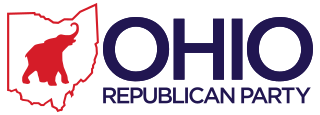
The Ohio Republican Party is the Ohio state affiliate of the United States Republican Party. It was founded in Columbus, Ohio on February 13, 1854.
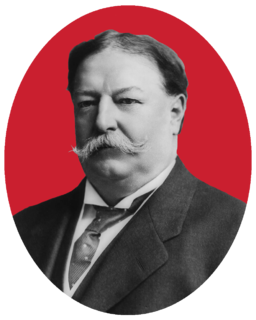
The 1908 Republican National Convention was held in Chicago Coliseum, Chicago, Illinois on June 16 to June 19, 1908. It convened to nominate a successor to the popular GOP President, Theodore Roosevelt and his Vice President, Charles W. Fairbanks.
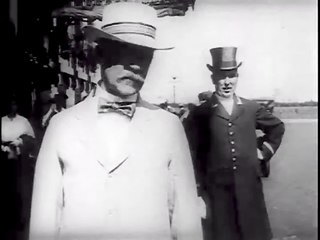
The 1916 Republican National Convention was held in Chicago from June 7 to June 10. A major goal of the party's bosses at the convention was to heal the bitter split within the party that had occurred in the 1912 presidential campaign. In that year, Theodore Roosevelt bolted the GOP and formed his own political party, the Progressive Party, which contained most of the GOP's liberals. William Howard Taft, the incumbent president, won the nomination of the regular Republican Party. This split in the GOP ranks divided the Republican vote and led to the election of Democrat Woodrow Wilson. Although several candidates were openly competing for the 1916 nomination—most prominently conservative Senator Elihu Root of New York, Senator John W. Weeks of Massachusetts, and liberal Senator Albert Cummins of Iowa—the party's bosses wanted a moderate who would be acceptable to all factions of the party. They turned to Supreme Court Justice Charles Evans Hughes, who had served on the court since 1910 and thus had the advantage of not having publicly spoken about political issues in six years. Although he had not sought the nomination, Hughes made it known that he would not turn it down; he won the nomination on the third ballot. Former Vice-President Charles W. Fairbanks was nominated as his running mate. Hughes was the only Supreme Court Justice to be nominated for president by a major political party. Fairbanks was the last former vice president, to be nominated for vice president.

The 1900 National Convention of the Republican Party of the United States was held June 19 to June 21 in the Exposition Auditorium, Philadelphia, Pennsylvania. The Exposition Auditorium was located south of the University of Pennsylvania, and the later Convention Hall was constructed along the building's east wall. It was demolished in 2006.

The presidency of Warren G. Harding began on March 4, 1921, when Warren G. Harding was inaugurated as President of the United States, and ended when he died on August 2, 1923, a span of 881 days. Harding, the 29th United States president, presided over the country in the aftermath of World War I. A member of the Republican Party, Harding held office during a period in American political history from the mid-1890s to 1932 that was generally dominated by his party. He died of heart attack and was succeeded by Vice President Calvin Coolidge.
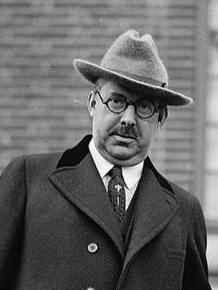
Jesse W. "Jess" Smith was a member of President Warren G. Harding's Ohio Gang. He was born and raised in Washington Court House, Ohio, where he became a friend of Harry M. Daugherty. There, Daugherty helped him to become the successful owner of a department store. Smith became Daugherty's gofer during the 1920 campaign.
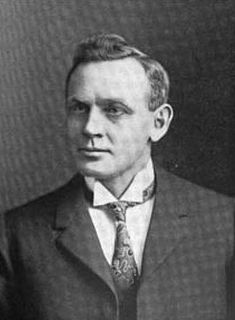
Frank Edgar "Ed" Scobey (1866–1931) was Director of the United States Mint from 1922 to 1923.
On January 12, 1898, the Ohio General Assembly met in joint convention to elect a United States Senator. The incumbent, Mark Hanna, had been appointed by Governor Asa Bushnell on March 5, 1897, to fill the vacancy caused by the resignation of John Sherman to become Secretary of State to President William McKinley. Hanna's appointment was only good until the legislature met and made its own choice. The legislature elected Hanna over his fellow Republican, Cleveland Mayor Robert McKisson, both for the remainder of Sherman's original term and for a full six-year term to conclude in 1905.

The 1920 United States presidential election in New Jersey took place on November 2, 1920. All contemporary 48 states were part of the 1920 United States presidential election. New Jersey voters chose 14 electors to the Electoral College, which selected the president and vice president.
